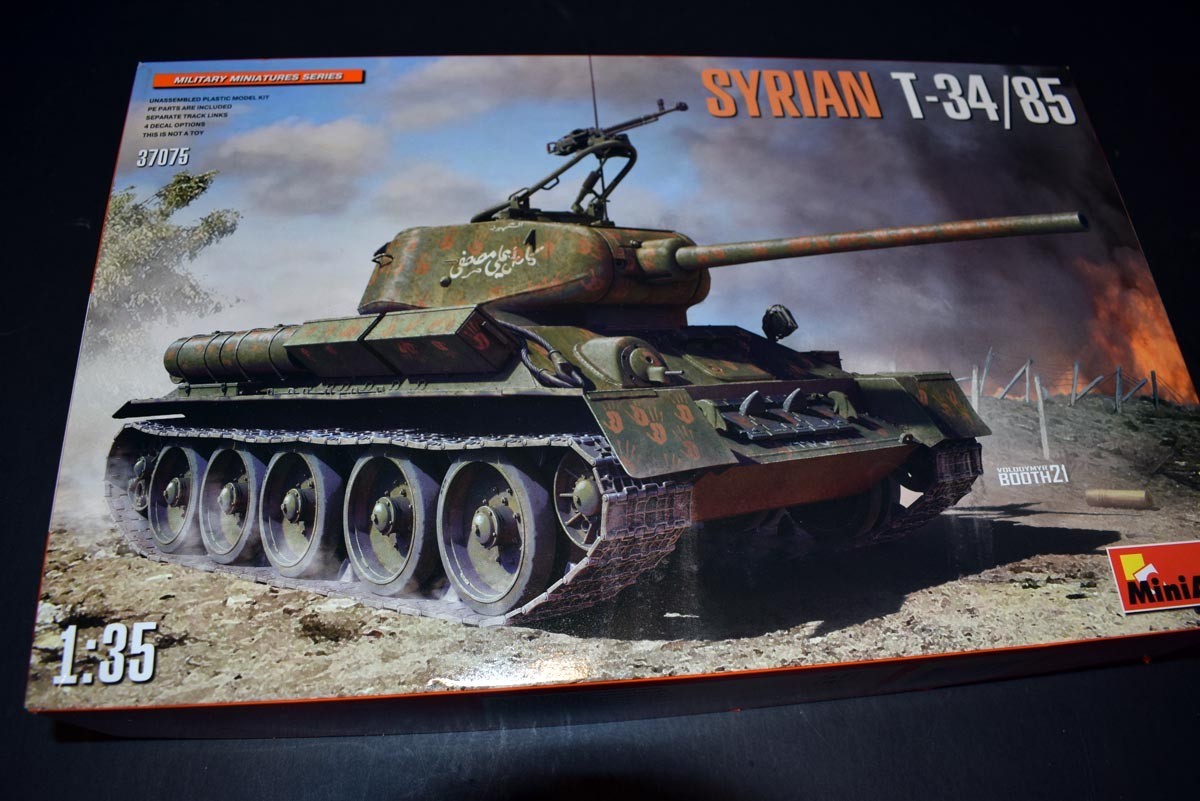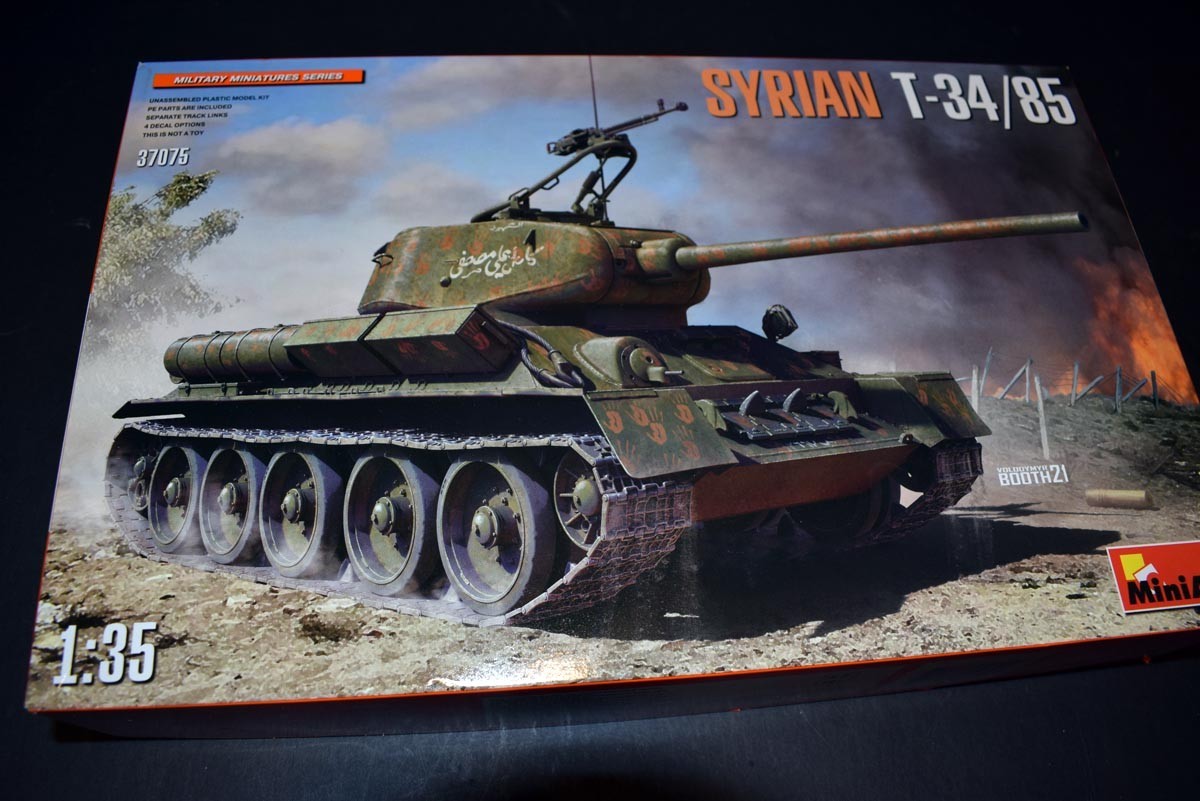
Introduction
The T-34 family of tanks in terms of number built, countries utilising and length of time they have been used must mark it as one of the widest spread and longest serving tanks in world history. First seeing combat in World War II, T-34s were even used during recent civil unrest in various areas of Eastern Europe, and due to the large quantities produced in various types, both by the former Soviet Union, and under contract I believe some T34s are still in service in Bosnia and Herzegovina, North Korea and some African countries. This release in 1/35thscale, covers a T-34/85s in Syrian use from 1960 through to the early 1970s.
Review
This offering from MiniArt is packaged in the usual manner, of a cardboard tray with a separate card lid showing the artwork for the model. Inside is a single plastic bag containing all of the parts, with the exception of the instruction booklet. Decals and clear parts have been packaged inside their own plastic within the package, and I do wish that MiniArt would package their decals separately from their models parts. On the plus side the photo etch is provided inside its own card envelope, which usually does a very good job of protecting the contents. Moulding quality is as usual, of a good standard with the only visible detriments being flow marks, which do not look or feel to have marred the finish. Access for removal of parts is good, but with care being required during removal of some of the pieces due to their finesse.
The T-34/85 is a line of kits that are offered by MiniArt with or without interiors, and this means that some aspects of the interior of the model are present despite this not being an interior model. The lower hull of the model, is assembled from separate panels that has allowed the provision of a very high quality of detail on all faces. This approach of separate panels, could make getting the orientation of the various panels correct, difficult, but due to MiniArt having provided the bulk head between the engine and crew compartment, you have a part that supports the structure making assembly easier.
The suspension for the model is via springs and struts, and while these are present they are not workable and will not be seen on the finished model. As such, showing this model on an uneven surface will prove difficult and so think about what you want to do, before getting carried away. The suspension arms are as I said previously fixed for a level surface, and so if displaying on an uneven surface you will need to give consideration as to how this is going to be accomplished; cutting and reducing length seems the only method to me. The wheels themselves have a high level of moulded on detail on all sides, which is something I like to see. The tracks provided are individual track links that are accurate in their depiction, but require a high degree of care and attention while cleaning them up to ensure a pleasing and good fit. This is from experience, and trying to tackle it quickly is something I strongly advise against.
The upper hull of the model, is also made of separate panels, but in this case I believe it to be not just due to the prospect of having an interior, but also to allows for the hundreds of differences in the T34 family. The hatches that would cover the engine if present, and the drivers hatch can be open or closed depending on your preference, and if you place a figure behind the hatch I believe that would be perfectly acceptable. The detail on the hatch cover itself, is simplistic on the outside as indeed it should be, but all the little bits and bobs on the interior side are present. Stowage bins, grab handles, and exposed elements are well catered for, especially the fuel tanks, which have been provided with photo etch straps. The tow cables have been provided via the inclusion of separate hoops, but you need to supply the cable between. I would usually complain about this aspect, however as I have discovered modellers have their own preferences for the material to replicate cables, and so this is a perfectly acceptable approach.
The turret of the model is provided with panels for interior detail that will be pleasing for those modellers that want the hatches open, as it means there is something to see rather than empty holes. The hatches on the turret have good detail on both the inner and outer surfaces, and includes clear lenses for the view ports. The breach of the main gun and ranging machine gun, offers a good degree of detail inside the turret, and I am very pleased that the main gun barrel has been moulded as a single piece utilising slide moulding, making for ease of assembly and no major clean up issues. Grab handles are separate, and so realistic. Now there are a huge number of differences in the T-34/85, let alone the T-34family as a whole, and so I am not going to even attempt to decide what is and is not accurate. The one main difference which is picked up in this release, is the turret mounted heavy machine gun, primarily for air defence. This offers a substantial mount, that can be elevated on an hydraulic arm, but is a fixed elevation in this release. The gun itself, has a high level of detail but unfortunately has not been slide moulded, and so the muzzle will need to be drilled out for accuracy.
MiniArt has supplied four finishing options for this release, in the form of:
Syrian Armed Forces, Syria, Damascus, Early 1960s
Syrian Armed Forces, Six Day War, Summer 1967
Syrian Armed Forces, Six Day War, Summer 1967
Syrian Armed Forces, Presumably Yom Kippur War, Golan Heights, October 1973
Conclusion
Most model companies offer a T-34 tank model, however, these later vehicles are not very often catered for and so I am very pleased to see MiniArt tackling them. Details provided are of a very high standard, mainly due to separate panels in most cases which allows a high finesse of detail to be moulded as part of the whole. Critique wise I would have liked to have seen, the very prominent heavy machine on the turret having been slide moulded and please stop packing decals in with clear sprues due to the high risk of damage.

